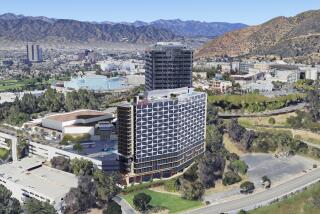A real Hollywood flop
On Thursday, the city’s planning commission is likely to consider a development proposal that will affect the lives of everyone who lives in Hollywood or passes through it on the Hollywood Freeway, one of the most congested in the nation.
The 1.1-million-square-foot development, Millennium Hollywood, would be twice the size of the Los Angeles Convention Center and allow a tower nearly 600 feet high, vastly out of proportion with today’s Hollywood. Its boosters say it would provide jobs, stimulate business, lure thousands of new tourists and “reinvigorate” Hollywood. The developers, a New York hedge fund and an owner of the land under Grand Central Station, are asking for an unprecedented 22-year contract to build out the sites just north of Hollywood and Vine.
Unprecedented too is the fact that, while the city sees this development as Hollywood’s future, there is no final design. We don’t know what it will look like or even what it will contain. The proposal includes more than four acres of high-rise luxury condos, offices, bars, boutique hotel rooms, restaurants and a vast fitness center, all encased in private towers so tall they will dwarf its centerpiece, the Capitol Records building. Slabs of Hollywood sky will be parceled out for private resale, and hundreds of thousands of cubic yards of dirt and debris will be hauled through city streets and onto the Hollywood Freeway for disposal.
Mayor Antonio Villaraigosa, who has fully embraced this vision for Hollywood, insists the whole thing will be so well served by public transportation that it will wean people from driving and contribute to his ambitious goal of moving people onto public transit. This kind of wishful thinking is what has allowed the city and project developers to assert, improbably, that the Millennium Project will have little impact on traffic, health, safety, roads and neighborhoods. The assertion is particularly specious when considered in light of the 57 other city-approved projects slated for Hollywood. If you’ve driven in Hollywood lately, you know how bad things have gotten. Do we really think massive new development will help that?
Caltrans, meanwhile, has formally notified the city that its traffic studies are inadequate and that the agency has strong doubts about findings that there will be “no significant impact” on the nearby Hollywood Freeway. It has also warned that the project could create dangerous driving conditions.
The environmental impact reports for the projects collectively run thousands of pages, with grids, appendices and an alphabet-soup of acronyms. But, for all the civic promises that this frenzied development will ensure Hollywood’s future, many of us are not convinced.
“We have no idea what will be built, except that it will likely be massive,” wrote Manatt, Phelps & Phillips attorney Victor de la Cruz, who represents the AMDA College and Conservatory of the Performing Arts, which occupies a campus of restored old buildings that will now be bisected by a staging area for what developers estimate will be 38 months of construction.
He goes on to note that the development agreement “allows different parts of the project site to be sold to different developers who may choose to build something that bears no real resemblance to the concept plan. This is all the more shocking given that the development agreement also provides that no subsequent approvals/environmental review would be required for any subsequent build-out of the project.”
A Hollywood resident for 28 years, I started looking at this project almost two years ago, when I heard about it almost by accident. Since then, I’ve come to see it as an outgrowth of a perfect civic compost: a city budget crisis, mayoral politics, an understaffed newspaper stretched too thin to fully scrutinize the project and New York developers who specialize in “public-private partnerships.”
I have also come to understand that while the city insists it wants to preserve local neighborhoods, its insistence on removing public parking from central Hollywood will make it impossible for those who already live nearby to take advantage of the “vibrant” new Hollywood.
The traffic analysis embraced by the developer doesn’t answer many crucial questions, including those affecting our access to police and fire protection. What happens on summer nights when the Hollywood Bowl draws 18,000 people to the neighborhood and Hollywood Boulevard’s bar patrons spill out into the street. And what kind of absurd math allows developers to claim that this project will require only two new police officers and no update of already substandard Fire Department response times?
The developer is in an understandable hurry to have the project approved while a supportive councilman (Eric Garcetti) and an enthusiastic mayor (Villaraigosa) are still in place. But some 40 neighborhood organizations oppose it. We think other Angelenos would agree with us if they understood the project.


